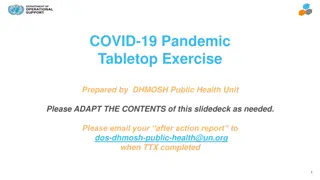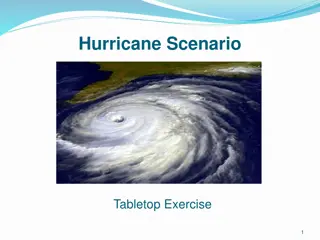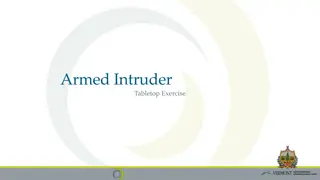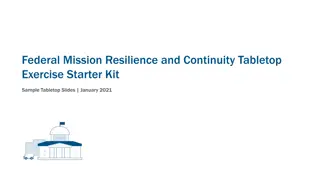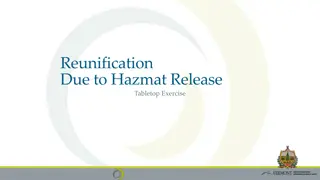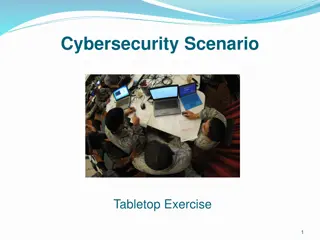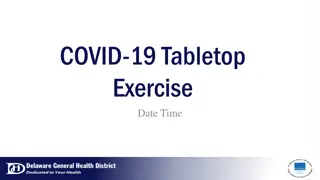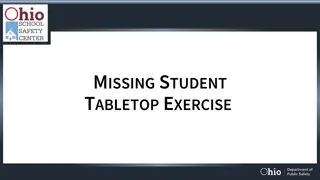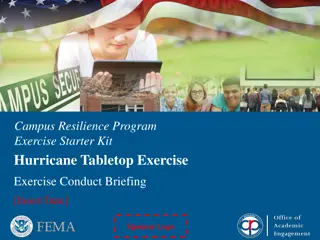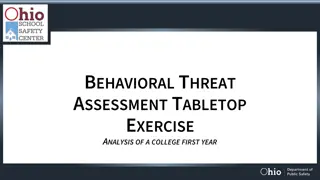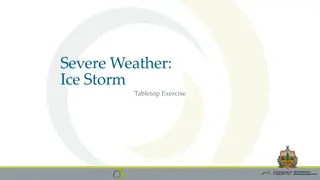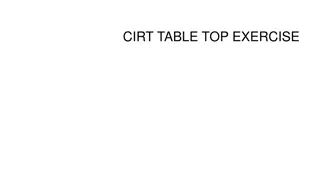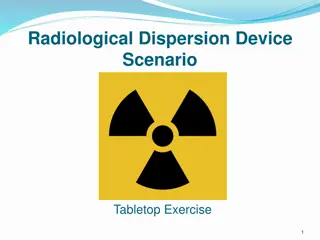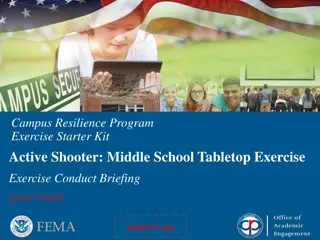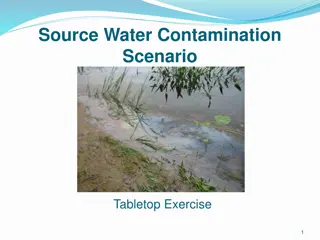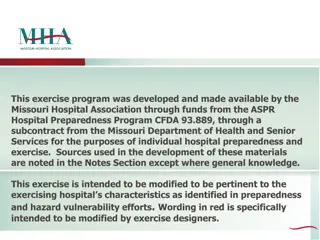COVID-19 Rural Community Tabletop Exercise Template
Create a comprehensive tabletop exercise plan to engage various community members and stakeholders in addressing COVID-19 challenges. Incorporate current situation updates, participant identification, exercise purpose, logistics, agenda, existing plans, and exercise ground rules. Outline scenarios covering prevention, testing, positive cases, care escalation, fatalities, and next steps. Utilize technology for remote participation, prioritize resource needs, and assess local priorities. Foster collaboration and preparedness for effective community response.
Download Presentation

Please find below an Image/Link to download the presentation.
The content on the website is provided AS IS for your information and personal use only. It may not be sold, licensed, or shared on other websites without obtaining consent from the author.If you encounter any issues during the download, it is possible that the publisher has removed the file from their server.
You are allowed to download the files provided on this website for personal or commercial use, subject to the condition that they are used lawfully. All files are the property of their respective owners.
The content on the website is provided AS IS for your information and personal use only. It may not be sold, licensed, or shared on other websites without obtaining consent from the author.
E N D
Presentation Transcript
COVID-19 RURAL COMMUNITY RESPONSE TABLETOP EXERCISE TEMPLATE
Current Situation Updates Brief overview of current situation
Exercise Participants Determine who should be at the table (ideas): City / Tribal Administrator Clinic / Hospital VPSO / Fire / EMS / VPO / TPO / Search & Rescue Community Emergency Manager / LEPC Members School Administrators Food and Housing Service Providers Public Works / Utilities / Transportation Elders Critical Industry Airline Agent Faith-based Representative Translators
Exercise Purpose and Scope What planning issues does your community want to confirm/clarify? Exercise facilitator introduces the purpose of the Exercise Assessment of Local Priorities Identify Strengths and Best Practices Identify and prioritize gaps and resource needs
Exercise Schedule and Logistics Date, time, duration, location (avoid gathering in one location to promote physical distancing) How will the Exercise be conducted (what technology is available for remote participation)? Who will facilitate the Exercise? Who will assist with technology, timekeeping, etc.? Who will take notes and be responsible for completing a report of the Exercise Summary? What materials should be available to participants prior to the Exercise? (Existing Small Community Emergency Response Plans, etc.)
Exercise Agenda 1. Current Situation 2. Exercise Introduction 3. Module 1: Prevention 4. Module 2: Testing 5. Module 3: Positive COVID-19 Case 6. Module 4: Increased Level of Care 7. Module 5: Fatality 8. Next Steps and Summary
What Plans are Already in Place? 1. Permission from the Elders 2. Emergency Operations Center (EOC) / Incident Management Team (IMT) Activated 3. Disaster Declaration 4. Flight Restrictions or other travel restrictions 5. Small Community Emergency Response Plan (SCERP)
Introduce the Exercise Process Ground Rules: Exercise is being conducted in an open, low-stress, no-fault environment; varying viewpoints are expected Decisions are not final; this is an open discussion, we are not creating rules right now Focus should be on identifying suggestions and recommended actions for improving preparedness and response efforts This is not a test of current capabilities and plans. It is a discussion of probable responses to the current situation and consequent cascading events. The exercise will be an open dialogue. All ideas and input are welcome. One person speaks at a time. Cell Phones on vibrate
Introduce the Exercise Safety and Security: Emergency Notifications Introductions: Name Title/Role Organization What are you Currently Working On
Module 1: Prevention You do not yet have any cases of COVID-19 in your community.
Module 1: Discussion Questions Personal hygiene and environmental cleaning Do you have guidance for people who do not have running water on how to perform hand hygiene? What about community shower/laundry facilities how can these be used safely? What is your supply of cleaning products (i.e. bleach, hand sanitizer, disinfecting wipes, etc.)? How is this information collected? Are your facilities willing to share resources with each other? If you need additional supplies, who are you working with to acquire more? Communication How are you communicating the recommendations to your entire population? Who is responsible for getting out this information?
Module 1: Discussion Questions (cont.) Social Distancing (NOT Social Isolation) Communication: How is this being communicated in your community? Are there people who do not yet follow the recommendations? If so, who do they trust and listen to? What is the plan or what could you do to get trusted messengers to communicate about social distancing with people who are not yet practicing it? Logistics: How is this being accomplished in your community? What are the unmet needs in your community due to closures (i.e. school lunches, education, etc.)? What are the challenges coming from closures and staff self-quarantining?
Module 1: Resources Communication Local radio station, VHF, Facebook groups, email listserves Internal messaging Examples of how to do trusted messenger and multilingual local leader communications campaigns: Personal Hygiene/Environmental Health https://www.cdc.gov/vhf/ebola/pdf/making-hand-washing-solution-bleach-hth.pdf https://www.cdc.gov/handwashing/pdf/hand-sanitizer-factsheet.pdf
Module 2: Testing You have symptomatic people in your community who qualify for COVID-19 testing.
Module 2: Discussion Questions Where is the specimen collection being done? What is the protocol for entering the specimen collection site? (i.e., call-ahead policy) Who is doing the collection? Do they have enough PPE and training? Where are the kits being sent for testing? Can they get to the lab within 72 hours? Does the community know how to determine if they have cases? How are test results being communicated? How is the patient being isolated while awaiting test results? Are there elders or immunocompromised people in the home making self-isolation at home not possible? Are there alternate locations where people awaiting test results could be housed? If the patient is isolated away from their children or others for whom they have caretaking responsibilities, who will provide this care?
Module 2: Resources Specimen Collection Supply Request Form Alaska State Public Health Laboratories http://dhss.alaska.gov/dph/Labs/Documents/publications/LabSupplyRequest.pdf Alaska State Virology Lab Fairbanks Lab Request Form https://go.dhss.ak.local/pub/home/dph/Labs/Documents/publications/FbxSupplyReq.pdf Commercial Lab Contact Information State of Alaska Case Counts and Testing Data http://dhss.alaska.gov/dph/Epi/id/Pages/COVID-19/monitoring.aspx
Module 3: Positive COVID-19 Case There is a positive COVID-19 test result for someone in your community.
Module 3: Discussion Questions How will the patient be informed of positive test results? Where will the patient be safely isolated if their symptoms are not severe enough that they require healthcare services? What transportation services are available to transport the patient if their symptoms worsen? How will the patient get food and other necessities? Who will care for the patient s children or others for whom they have caretaking responsibilities?
Module 3: Resources Getting necessary supplies and services to people who are self-isolating Local food banks Mental health services or telemedicine Cleaning/Laundry Services Public Health Nurse telephone monitoring Transportation of ill patients Alternate Housing for ill patients
Module 4: Increased level of care A person in your community needs a level of care not available in your community.
Module 4: Discussion Questions What are the trigger points for sending someone outside of the community for an increased level of care? Where will the patient receive medical care? If this requires transportation, how will this be accomplished? Is there PPE for the patient transporters? If transportation to higher acuity care facility is delayed, where will person be housed?
Module 4: Resources Local / Regional Healthcare Resources Local Emergency Medical Services Medevac Services
Module 5: Fatalities A critically ill patient infected with COVID-19 dies in the community.
Module 5: Fatalities How and where will this person s body be stored? How and who will transport them? Is there adequate PPE for this task and are there cadaver/post mortem bags in the community? Will a Medical Examiner need to be involved? Will the body be buried/cremated? How will planes and transport vehicles be cleaned?
Next Steps Identify Strengths and Best Practices Identify and prioritize gaps and resource needs Identify who will manage immediate needs and local process for making resource requests Local or Regional Emergency Operation Center (EOC) State Emergency Operations Center (SEOC) Complete a summary report of the Exercise, including all identified strengths, best practices, gaps and resource needs.



